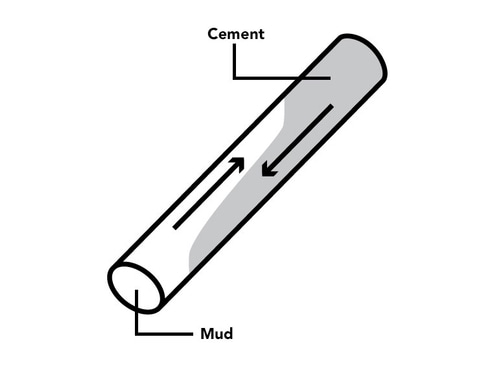When a cement plug is placed off-bottom in a wellbore, it is quite common that it is not found where it is expected. And even if it is, the cement plug is often too soft or fails to provide a hydraulic seal. Normally, this is due to contamination of the cement - aka 'green cement'. There can be several reasons to why cement plugs becomes contaminated.
As a driller or cementing professional, you know that it will not be possible to kick off from a contaminated plug.
Let's look at some common causes of this and how you can avoid failure in the first place.
1. Downward movement of the cement slurry
The typical off-bottom cement plug operation involves placing a higher density cement plug above a lighter well fluid. In such applications, you need to keep the cement slurry stable and in place until it has set.

2. Improper well fluid removal
Poor removal of well fluid in the area where the cement plug is to be set can result in channels of drilling fluid through the cement plug. These channels can create problems in obtaining a hydraulic barrier.
All precautions should be taken to break up the well fluid by circulating over the whole interval where the cement plug is to be set.
3. Insufficient slurry volume
Ideally, in open hole applications, a caliper should be run prior to a cement plug operation. The caliper run provides hole size information and helps estimate the required cement slurry volume.
As an extra run is costly, this challenge is often reduced to an acceptable level by using higher excess volumes of cement.
4. Poor job execution
No matter how well the operation is planned or what equipment is used, the job execution itself is critical in a cement plug operation.
As the volumes generally are small, the personnel involved in the placement operation need to understand the hydraulics to place the cement slurry successfully.
5. Poor slurry design
To maximize the success of setting cement plugs the cement slurry should be designed for the specific application. There are many parameters and additives which are crucial to avoid contaminated cement.
Slurry design affects thickening time, slurry pumping properties, fluid loss properties, etc.
6. Incorrect well parameter
To be able to design the perfect cement slurry, it is important to have the correct well parameters. Before a cement operation is executed, the slurry is tested in a laboratory with the exact well parameters to ensure the slurry performs as required.
If incorrect well parameters are used in these tests, the slurry will most likely not be ideal for the application.
A very common deviation from the laboratory test is thickening time for the slurry. It is therefore important to have accurate well parameters to ensure the slurry performs as required.
Solutions: Your options
A high-viscous pill can be placed below the cement plug to prevent the cement slurry moving downwards. If correctly placed, the pill will help avoid contamination and therefore increase the success rate.
Aside from placement technologies in fluid form there are also mechanical technologies. In cased hole application it is possible to use a bridge plug and in open hole applications an inflatable packer can be used.
Additionally, cement support tools can be used in both cased hole and open hole applications. One important difference between the cement support tools and the other mechanical placement technologies is that the cement support tool can be deployed through the cement work string itself.
Another is how it performs in open hole applications when it does not anchor. These major differences result in significant variation when it comes to success rates and cost.
These are a few of the most common reasons, according to our experience. If you have different or additional experiences, please let us know in the comments field below.
If you would like to go further into details on the optional technologies at hand, please download this free white paper:




